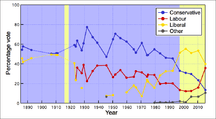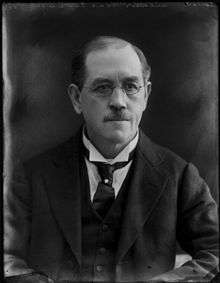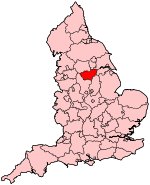Coordinates: 53°21′18″N 1°31′23″W / 53.355°N 1.523°W / 53.355; -1.523
Sheffield Hallam is a constituency[n 1] represented in the House of Commons of the UK Parliament since 2005 by Nick Clegg, former leader of the Liberal Democrats and former Deputy Prime Minister.[n 2]
Constituency profile
Sheffield Hallam is the only constituency in South Yorkshire that is not a Labour stronghold. It is currently the only seat in the county that is not held by Labour, and it has never returned a Labour MP since its first election in 1885 and, apart from a brief period between 1916 and 1918, was held by the Conservatives from 1885 until 1997, when the Liberal Democrats won it. This long period of Conservative dominance included all 3 elections under Margaret Thatcher's premiership, starkly contrasting with the consensus within most seats in the county and the other county which Sheffield Hallam borders, Derbyshire.
In a 2013 survey by The Campaign to End Child Poverty, Sheffield Hallam was found to be the constituency with the lowest level of child poverty in the UK, at under 5%.[2]
On income-based 2004 statistics this is the most affluent constituency one place below the top ten seats of the 650, which were spread across the South East of England (including London), with almost 12% of residents earning over £60,000 a year.[3] This measure placed Sheffield Hallam above Windsor and Twickenham.
Based on 2011–12 income and tax statistics from HMRC,[4] Sheffield Hallam has the 70th highest median income of the 650 parliamentary constituencies, with those above it almost exclusively in London and the South East, and notably placing it ahead of Tunbridge Wells (76th), The Cotswolds (92nd), Cambridge (97th), Hemel Hempstead (103rd), and David Cameron's Witney constituency (121st).
The 2001 Census showed Hallam to have the highest number of people classified as professionals of any of the UK constituencies.[5] Furthermore, 60% of working age residents hold a degree,[6] 7th highest and exceeding Cambridge.[n 3]
Until the 1997 general election, the constituency was a safe Conservative seat. It has been represented in the House of Commons since May 2005 by Nick Clegg, who has been leader of the Liberal Democrats since December 2007 and Deputy Prime Minister since May 2010. He won his seat in Parliament for the first time at the 2005 general election.
Hallam constituency extends from Stannington and Loxley in the north to Dore in the south and includes small parts of the city centre in the east. It includes the wards of Crookes, Dore and Totley, Ecclesall, Fulwood and Stannington.
The large majority of Hallam is rural, spreading in the west into the Peak District National Park. It also contains some of the least deprived wards in the country, has low unemployment (1.5% jobseekers claimants in November 2012)[7] and a high rate of owner occupancy with few occupants who rent their home.[8] Since the 2010 boundary changes, neither of Sheffield's universities have a campus in the constituency[9] but it still includes areas where many students live.
Boundaries
1885-1918: The Municipal Borough of Sheffield wards of Nether and Upper Hallam, and parts of the wards of Ecclesall and St George's.
1918-1950: The County Borough of Sheffield wards of Crookesmoor and Hallam, and part of Broomhill ward.
1950-1955: The County Borough of Sheffield wards of Broomhill, Ecclesall, and Hallam.
1955-1974: The County Borough of Sheffield wards of Broomhill, Crookesmoor, Ecclesall, and Hallam.
1974-1983: The County Borough of Sheffield wards of Broomhill, Dore, Ecclesall, Hallam, and Nether Edge.
1983-1997: The City of Sheffield wards of Broomhill, Dore, Ecclesall, Hallam, and Nether Edge.
1997-2010: The City of Sheffield wards of Broomhill, Dore, Ecclesall, and Hallam.
2010-present: The City of Sheffield wards of Crookes, Dore and Totley, Ecclesall, Fulwood, and Stannington.
Hallam[n 4] borders High Peak, North East Derbyshire, Penistone and Stocksbridge, Sheffield Central, Sheffield Heeley and Sheffield Brightside and Hillsborough.
History
Prior to its creation Hallam was a part of the larger Sheffield Borough constituency, which was represented by two Members of Parliament (MPs). In 1885 the Redistribution of Seats Act, which sought to eliminate constituencies with more than one MP and for the first time allow approximately equal representation of the people, led to the break-up of the constituency into five divisions: each represented by a single MP, as today. Hallam was one of these new divisions. Its first MP, the Conservative Charles Stuart-Wortley, had previously been an MP in the Sheffield constituency, elected for the first time in 1880.
Hallam was regarded in 2004 as the wealthiest constituency in the north of England[3] and was long held by the Conservative Party. At the 1997 general election Richard Allan of the Liberal Democrats took the seat with an 18.5% swing.
Constituency polls during the 2010–2015 Parliament
Due in part to the high profile of the constituency's incumbent MP Nick Clegg, who served as Deputy Prime Minister during the 2010–15 Parliament, Sheffield Hallam is unusual in having had seven constituency-specific opinion polls conducted between 2010 and 2015. Each of these polls have suggested significant changes in the vote share compared to 2010 general election. The first poll, in October 2010, suggested a drop in the Lib Dem lead in the seat to just 2%, from nearly 30% at the general election five months earlier. Five of the six remaining polls, which appeared between May 2014 and May 2015, suggested that Labour was in the lead in the seat by this time, with the Labour lead fluctuating to between 1% and 10%, and one put the Lib Dems in the lead. On average across all seven opinion polls, Labour has a lead over the Lib Dems of 2.5%. The Conservatives came second in one poll, and third in the other six polls. It should be noted that the May 2015 ICM poll scores displayed are those of the constituency voting intention question. The same poll also carried the standard voting intention question, which showed a Labour lead. [10][11][12][13][14][15][16]
Members of Parliament
The current Member of Parliament is Nick Clegg, the former leader of the Liberal Democrats and Deputy Prime Minister. He won the seat after the previous Lib Dem MP Richard Allan retired at the 2005 general election. After Sir Menzies Campbell's resignation in October 2007 as leader of the Liberal Democrats, Clegg contested the resulting leadership election and was elected leader on 18 December 2007. He became Deputy Prime Minister in the coalition government of Conservative and Liberal Democrats in May 2010, but resigned as party leader following the May 2015 general election in which his party was reduced to just eight seats in parliament, but continues to sit as a backbench MP.
Elections

Election results for Sheffield Hallam
Elections in the 2010s
In 2010, Sheffield Hallam was one of a number of constituencies which experienced problems on polling day leading to some people being unable to cast their vote. In this case, voters at the Ranmoor polling station were subjected to long queues and some voters were turned away when polls closed at 10 pm, with Liberal Democrat candidate Nick Clegg apologising to those voters affected. Acting Returning Officer John Mothersole said that staff had been "caught out" by a high turnout, and the Electoral Commission instigated a review of procedures in Hallam and other constituencies where similar problems had occurred.[22]
Elections in the 2000s
Elections in the 1990s
Elections in the 1980s
Elections in the 1970s
Elections in the 1960s
Elections in the 1950s
Elections in the 1940s
Elections in the 1930s
Elections in the 1920s
Elections in the 1910s
- 1916 by-election
This followed the resignation of Charles Stuart-Wortley on 16 December. Herbert Fisher of the Liberal Party was elected unopposed, becoming Hallam's first non-Conservative MP.

Arthur Neal
Elections in the 1900s
Elections in the 1890s
Elections in the 1880s
See also
Notes
- ↑ A county constituency (for the purposes of election expenses and type of returning officer)
- ↑ As with all constituencies, the constituency elects one Member of Parliament (MP) by the first past the post system of election at least every five years.
- ↑ Also above Cities of London and Westminster and Hammersmith and Fulham.
- ↑ The constituency should not be confused with the former Hallamshire constituency.
- ↑ Knighted in 1928 and appointed Governor of Bombay
- ↑ At the 1997 general election the seat saw an unprecedented 18.2% one-party swing from the other parties, particularly the large Conservative vote, towards the Liberal Democrat winning candidate.
- ↑ After 28 years as MP for the seat, John Osborn stood down at the 1987 general election. His replacement as the Conservative Party candidate, local businessman Irvine Patnick, held the seat for the Conservatives with a slightly reduced majority.
- ↑ Clive Betts, the losing Labour candidate at the October 1974 general election, won the Sheffield Attercliffe seat in 1992.
- ↑ David Blunkett, the losing February 1974 Labour candidate, won the Sheffield Brightside seat in 1987 enabling his later positions in government as Secretary of State (1997-2005).
- ↑ The constituency boundaries were redrawn prior to the February 1974 general election, perhaps accounting for the reduced majority of the incumbent, John Osborn.
- ↑ "Conservative and Liberal"
- ↑ "Conservative and Liberal"
- ↑ "Conservative and Liberal"
- ↑ "Conservative and Liberal"
- ↑ "Conservative and Liberal"
- ↑ The 1928 by-election followed the resignation of Frederick Sykes on June 26 to take up an appointment as Governor of Bombay.
References
- ↑ Sheffield Hallam UK Polling Report
- ↑ The Campaign to End Child Poverty Daily Mail
- 1 2 Wealth hotspots 'outside London' BBC News
- ↑ Income and tax by Parliamentary constituency HMRC
- ↑ Sheffield - a city of class division The Guardian
- ↑ UCU - University and College Union - National ranking - degree level and above University and College Union
- ↑ Unemployment claimants by constituency The Guardian
- ↑ "2011 Census Interactive - ONS". ons.gov.uk.
- ↑ "OpenStreetMap". openstreetmap.org.
- ↑ Populus/Lord Ashcroft opinion poll of Sheffield Hallam, 1–4 October 2010, full data charts
- ↑ ICM/Lord Oakeshott opinion poll of Sheffield Hallam, 29 April-4 May 2014, full data charts
- ↑ Survation/Lord Ashcroft opinion poll of Sheffield Hallam, 20–22 November 2014, full data charts
- ↑ Survation/Unite opinion poll of Sheffield Hallam, 22–29 January 2015, full data charts
- ↑ Lord Ashcroft opinion poll of Sheffield Hallam, 22-28 March 2015, full data charts
- ↑ Lord Ashcroft opinion poll of Sheffield Hallam, 22-28 April 2015, full data charts
- ↑ ICM/Guardian opinion poll of Sheffield Hallam, 1-3 May 2015, Guardian report
- ↑ This poll originally, erroneously, showed a small lead for the LDs: see http://lordashcroftpolls.com/2015/02/sheffield-hallam-doncaster-north-thanet-south/#more-7536
- ↑ "Election Data 2015". Electoral Calculus. Archived from the original on 17 October 2015. Retrieved 17 October 2015.
- ↑ "Sheffield Hallam". BBC News. Retrieved 14 May 2015.
- ↑ "Election Data 2010". Electoral Calculus. Archived from the original on 17 October 2015. Retrieved 17 October 2015.
- ↑ "Sheffield Hallam". Election 2010. BBC News. 7 May 2010. Retrieved 11 May 2010.
- ↑ "Nick Clegg apologises to voters in polling queues". BBC News. 7 May 2010. Retrieved 11 May 2010.
- ↑ "Election Data 2005". Electoral Calculus. Archived from the original on 15 October 2011. Retrieved 18 October 2015.
- ↑ "Election Data 2001". Electoral Calculus. Archived from the original on 15 October 2011. Retrieved 18 October 2015.
- ↑ "Election Data 1997". Electoral Calculus. Archived from the original on 15 October 2011. Retrieved 18 October 2015.
- ↑ "Sheffield Hallam". ElectionWeb Project. Cognitive Computing Limited. Retrieved 20 May 2016.
- ↑ "Election Data 1992". Electoral Calculus. Archived from the original on 15 October 2011. Retrieved 18 October 2015.
- ↑ "Election Data 1987". Electoral Calculus. Archived from the original on 15 October 2011. Retrieved 18 October 2015.
- ↑ "Election Data 1983". Electoral Calculus. Archived from the original on 15 October 2011. Retrieved 18 October 2015.
External sources



